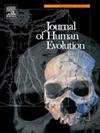A normal magnetostratigraphic polarity interval in the Main Ethiopian Rift at 1.6 Ma: Implications for Acheulean and Homo erectus chronology
IF 3.1
1区 地球科学
Q1 ANTHROPOLOGY
引用次数: 0
Abstract
The timing of Homo erectus and Acheulean emergence in the Early Pleistocene is important to the understanding of the evolution of the genus Homo but is currently insufficiently resolved. Relevant chronologies are often based on a combination of radioisotopic dates and other age indicators such as magnetostratigraphy and biochronology. Here, we report a newly recognized normal magnetozone at ∼1.6 Ma in the Konso Formation, southern Main Ethiopian Rift, Ethiopia. This magnetozone occurs at one of the Konso Fm localities, KGA19, that spans the >1.75- to <1.45-Ma time period otherwise ill-represented in the Formation. We describe the lithostratigraphy and tephrostratigraphy of the KGA19 sedimentary sequence and demonstrate that the Konso Fm Kayle Tuff-1 and the KGA19 Bench Tuff are correlative to the Turkana Basin Orange and Morutot tuffs, respectively. Paleomagnetic analyses of the western sector of KGA19 revealed a normal polarity interval at ∼1.6 Ma, with its age based on 40Ar/39Ar dates and tephrostratigraphic correlations. This suggests that the KGA19 normal magnetozone represents the Gilsá excursion otherwise documented in limited marine cores, Chinese Loess sequences, and few lava flows. A review of these records and sediment accumulation rates of fossil-bearing sequences of eastern Africa suggests that short events such as the Gilsá excursion would be detected if sampling resolution is sufficiently high relative to sedimentation rates. In light of these findings and considerations, evaluation of the Melka Kunture magnetostratigraphy suggests that the age of the Garba IV H. erectus and Acheulean is ∼1.6 Ma, not >1.95 to ∼2 Ma.
埃塞俄比亚主裂谷1.6 Ma的正常磁地层极性间隔:对阿舍利人和直立人年代学的启示
直立人和阿舍利人在更新世早期出现的时间对理解人属的进化很重要,但目前还没有充分解决。相关的年代学通常基于放射性同位素年代和其他年龄指标(如磁地层学和生物年代学)的结合。在这里,我们报告了埃塞俄比亚主裂谷南部Konso组在~ 1.6 Ma处新发现的正常磁带。这个磁带出现在Konso Fm的一个位置KGA19,它跨越了1.75- 1.45 ma的时间段,否则在该组中就没有表现出来。通过对KGA19沉积层序岩石地层学和地层地层学的描述,证明了Konso Fm Kayle Tuff-1和KGA19 Bench Tuff分别与图尔卡纳盆地Orange和Morutot凝灰岩具有相关性。古地磁分析表明,KGA19西段具有~ 1.6 Ma的正常极性区间,其年龄基于40Ar/39Ar年代学和地层对比。这表明,KGA19正磁带代表了在有限的海相岩心、中国黄土层序和少量熔岩流中记录的gils偏移。对这些记录和东非含化石序列沉积物积累速率的回顾表明,如果采样分辨率相对于沉积速率足够高,就可以检测到诸如吉尔斯偏移这样的短期事件。根据这些发现和考虑,对Melka Kunture磁地层的评价表明,Garba IV H. erectus和Acheulean的年龄为~ 1.6 Ma,而不是1.95 ~ ~ 2 Ma。
本文章由计算机程序翻译,如有差异,请以英文原文为准。
求助全文
约1分钟内获得全文
求助全文
来源期刊

Journal of Human Evolution
生物-进化生物学
CiteScore
6.30
自引率
15.60%
发文量
104
审稿时长
3 months
期刊介绍:
The Journal of Human Evolution concentrates on publishing the highest quality papers covering all aspects of human evolution. The central focus is aimed jointly at paleoanthropological work, covering human and primate fossils, and at comparative studies of living species, including both morphological and molecular evidence. These include descriptions of new discoveries, interpretative analyses of new and previously described material, and assessments of the phylogeny and paleobiology of primate species. Submissions should address issues and questions of broad interest in paleoanthropology.
 求助内容:
求助内容: 应助结果提醒方式:
应助结果提醒方式:


